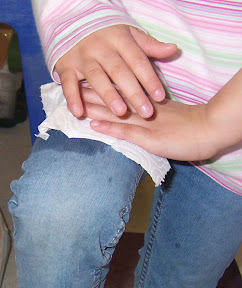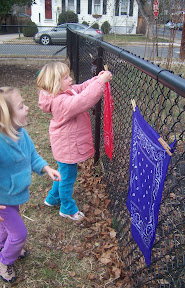Evaporation—children need to know the word and concept
By Peggy Ashbrook
Posted on 2010-04-11
 Is it surprising that there are no books for children titled “Evaporation”? Why this exciting subject doesn’t have it’s own title is beyond me—ha! But there are many good books that do touch on the subject in interesting ways. While we don’t need to dwell on the concept of evaporation, it should frequently be part of our vocabulary in early childhood classrooms to help children understand that water (and all matter) does not “disappear” or “go away”, but always exists, although in different forms.
Is it surprising that there are no books for children titled “Evaporation”? Why this exciting subject doesn’t have it’s own title is beyond me—ha! But there are many good books that do touch on the subject in interesting ways. While we don’t need to dwell on the concept of evaporation, it should frequently be part of our vocabulary in early childhood classrooms to help children understand that water (and all matter) does not “disappear” or “go away”, but always exists, although in different forms.
Here are a few resources about evaporation. What can you add to this list?
Online
CHEM4KIDS.com by Andrew Rader Studios
Prepare yourself to comfortably use the word “evaporation” by reading the definition and description of the process at:
http://www.chem4kids.com/files/matter_evap.html
Evaporation is a phase change—read more at:
http://www.chem4kids.com/files/matter_changes.html
Marvelous Explorations Through Science and Stories (MESS®) : Investigating Water. HHS/ACF/Office of Head Start. 2008.
Download a copy of the Teacher’s Guide, which describes many activities for hands-on exploration of the properties of water and its importance to all living things. The list of Recommended Materials includes a list of books on water.
In print
Down Comes the Rain (Let’s Read-and-Find-Out Science Book) by Franklyn M. Branley. (Scholastic Inc. 2000).
Frankly Branley’s timeless writing is engaging and accurate. The illustrations by James G. Hale include children speaking (words in balloons), promoting the concept that children do science. Read this book as an introduction to the topic of water (do the hands-on activities), or as a way to pull together children’s explorations, after the fact.
The Drop in My Drink: The Story of Water on Our Planet by Meredith Hooper. (Viking 1998). A wonderful book (with many references to evaporation) for reading aloud to just a few children because of the complexity of the path water takes around the world and the level of the vocabulary.
A Drop of Water by Walter Wick. (Scholastic 1997). The text, written for grades 3-6, will equip teachers with a good explanation of “molecules” for teaching that through evaporation, tiny pieces of water move into the air. The amazing photographs illustrate the properties of water for all ages.
River of Life by Debbie S. Miller, illustrated by Jon Van Zyle. (Clarion Books 2000). Focused on one body of water, a river in Alaska, and all the life that it supports, read this book to highlight how essential water is to life.
Where Did the Rain Puddle Go? Vol. 10 Evaporation (Winnie the Pooh’s Thinking Spot Series) by Dawn Bently. (Advance Publishers 2005).
Disney is not the company I usually think of when looking for a science title. But this book turned up on an internet search for books titled “evaporation”. I couldn’t find more information about the content, however, the description says that Pooh and friends learn “simple scientific facts while examining how young children learn through listening, questioning, observing, comparing, and experimenting” and there is a hands-on activity at the end. I shouldn’t be such a snob.
Where Do Puddles Go? by Fay Robinson (Childrens Press 1995) may inspire your class to make a puddle and then make observations over the period of recess, or a day.
Have you used the National Science Teachers Association website feature “NSTA Recommends” to look for “thoughtful, objective recommendations of science-teaching materials” on water, evaporation and any other topic? It’s available to all at no cost and also part of each journal. Here’s one sample of the results of my search for evaporation:
My World of Science: Water by Angela Royston
Price at time of review: $14.95
32 pp.
Heinemann Library
Chicago, IL
2001
ISBN: 1-58810-247-5
Grade Level: K-4
Reviewed by Monica Hayes
Middle School Teacher
“My World of Science: Water is one of ten books on physical science topics written for primary students by Angela Royston. Their conceptual level, format, and presentation make them excellent supplements to classroom activities for students at this level.
This book covers a great deal of content usually included in primary curricula: phases of water, the water cycle, and the dependence of all living things on water. The book also includes practical observations, like the water content of fruits and vegetables, and applications, such as using water to clean or fight fires. The author explores phase changes and movement of water through gravity and negative air pressure (suction). Activities demonstrate some of the more difficult concepts; for example, children can measure a puddle over time to observe evaporation. Students can also try to push a balloon under water to show that water pushes back. These experiences will help students to understand some of the unique properties of water.
Each book in this series is written at a second/third grade level to encourage independent reading, but also would be appropriate for younger students as a read-aloud. No background information is necessary for the teacher or parent. All of the books are trimmed in appealing primary colors, and photos of familiar objects at home or school place the concepts in an authentic context. These books are highly recommended for their child-friendly text and visual representations that are accurate and realistic.”
 Get the Early Years activity column, Where Did the Water Go? from the April 2010 issue of Science and Children. I’m off to water the just-sprouting pea plants because the good soaking rain from a few days ago has evaporated from the top few inches of soil,
Get the Early Years activity column, Where Did the Water Go? from the April 2010 issue of Science and Children. I’m off to water the just-sprouting pea plants because the good soaking rain from a few days ago has evaporated from the top few inches of soil,
Peggy
Disclaimer: The views expressed in this blog post are those of the author(s) and do not necessarily reflect the official position of the National Science Teaching Association (NSTA).


